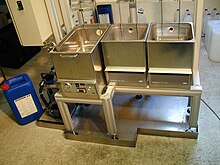Ultrasonic cleaning device
Ultrasonic cleaning devices are often used to clean small, complex and finely structured components. For example, jewelers , goldsmiths , dental technicians , watchmakers and opticians use ultrasonic cleaning baths to clean their products. In the medical industry, high-performance ultrasonic baths are used to reprocess surgical instruments. Blood and tissue residues can be effectively loosened from the joints of the instruments. In addition, the necessary exposure time for the disinfectant preparations is shortened by the ultrasound. In the automotive industry, ultrasonic baths are used to clean carburetors, spark plugs and injection nozzles.
Larger, industrial ultrasonic cleaning systems are used for cleaning raw parts such. B. used for surface finishing ( electroplating ).
construction
The system consists of a liquid-filled, possibly heatable tub, one or more ultrasonic transducers or ultrasonic transducers and a generator that supplies the transducer or transducers with high-frequency electrical energy. Sound transducers can be glued directly to the outside of the walls and under the floor of the tub, but only if the material thickness of the wall or floor is not too strong. With this construction, the ultrasound is then introduced directly into the liquid via the walls and / or floor. Another variant are so-called immersion transducers, which are hung in the liquid or attached to racks in the basin. Finally, there are plate transducers that are flanged to a corresponding opening in the pool wall.
The devices are usually made of stainless steel. The arrangement and distribution of the sound transducers must be such that a uniformly strong, non-static sound field is created. Some manufacturers therefore modulate the frequency to prevent standing waves . A function for degassing the cleaning liquid is also not unusual. The output power of the device is pulsed to enable any gas bubbles to rise to the surface. The background to this is the poor formation of cavitation bubbles in the presence of gas bubbles, as these would absorb the power. The minimum sound power required for a good cleaning result is around 35–40 W per liter of cleaning fluid. The sound generators need a minimum distance of 1–2 cm in order to develop a homogeneous sound field. Contact of the user with an active ultrasonic bath leads to an attack on the cell structure and should be avoided.
technology
Piezoceramic transducer systems are used to generate the ultrasonic vibrations . These are glued to the oscillating tank and contain a piezoceramic disc that expands or contracts when a voltage is applied. A high-frequency generator is used to generate ultrasound, which converts the mains frequency from 50 Hz to at least 20 kHz. The resonance frequency of an ultrasonic oscillating system is defined by the size and cannot be changed after manufacture.
Frequencies
Frequencies from 20 kHz to 400 kHz are usually used . Low frequencies around 20 kHz produce larger-diameter bubbles with powerful pressure surges, whereas higher frequencies around 35 kHz are better suited for intensive and gentle cleaning of surfaces. The currently usual frequency for particles with a diameter larger than 1 µm is around 200 kHz ("US"). The frequency range above 400 kHz to 1–2 MHz is also referred to as megasonic (“MS”) in the specialist literature. Here, particles with a diameter of less than 1 µm are optimally removed.
The frequency required is determined by the smallest opening or structure that can be cleaned by the sound. The wavelength in the water must be less than half the opening diameter. Otherwise the sound cannot penetrate and the surface would be smooth and closed for the sound effect.
application
The use of solvents , acids or alkalis significantly supports the cleaning effect of ultrasonic baths. In particular, the surface tension of the water must be reduced with a suitable cleaning product for effective ultrasonic cleaning. No flammable liquids are used as cleaning agents, since the ultrasound always introduces heat into the liquid, which could lead to ignition of the bath liquid if the ignition temperature is exceeded .
Ultrasonic baths are also used in sample preparation in order to tear apart biological substances in the analytical laboratory, i.e. to fragment them. Ultrasonic baths are used to disrupt cells or to shear DNA .
See also
Web links
- Christoph Drösser: Ultra clean. In: The time . No. 16, 2002 (accessed February 2, 2009).
Individual evidence
- ^ Kathy Barker: Cold Spring Harbor Laboratory Guide for Beginners. Elsevier, Munich 2006, ISBN 978-3-8274-1656-8 , p. 34.


